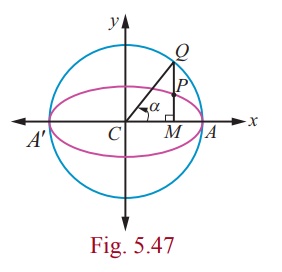Chapter: 12th Mathematics : UNIT 5 : Two Dimensional Analytical Geometry II
Parametric form of Conics
Parametric form of Conics
1. Parametric equations
Suppose f (t) and g(t) are functions
of 't '. Then the equations x = f (t) and y =
g(t) together describe a curve in the plane . In general 't '
is simply an arbitrary variable, called in this case a parameter, and this method of
specifying a curve is known as parametric equations. One important
interpretation of 't ' is time .
In this interpretation, the equations x = f (t) and y =
g(t) give the position of an object at time 't ' .
So a parametric equation simply has a third variable, expressing x
and y in terms of that third variable as a parameter . A parameter
does not always have to be 't ' . Using 't ' is more standard but
one can use any other variable.
(i) Parametric form of the circle x2 + y2 = a2

Let P(x, y) be any point on the circle x2
+ y2 = a2.
Join OP and let it make an angle θ with x -axis.
Draw PM perpendicular to x -axis. From triangle OPM
,
x = OM = a cosθ
y = MP = a sinθ
Thus the coordinates of any point on the given circle are (a cos θ, a sin θ) and
x = a cosθ , y = a sinθ , 0 ≤ θ
≤ 2π are the parametric equations of the circle x2
+ y2 = a2.
Conversely, if x = a cosθ , y = a sinθ , 0 ≤ θ ≤ 2π ,

Squaring and adding, we get,

Thus x2 + y2 = a2
yields the equation to circle with centre (0, 0) and radius a units.
Note
(1) x = a cos t, y = a sin t , 0 ≤ t ≤ 2π also represents the same parametric equations of circle x2 + y2 = a2 ,
t increasing in anticlockwise direction.

(2) x = a sin t,
y = a cos t, 0 ≤ t ≤ 2π also represents the
same parametric equations of circle x2 + y2
= a2,
t increasing in clockwise direction.

(ii) Parametric form of the parabola y2 = 4ax
Let P(x1 , y1) be a
point on the parabola
y12 = 4ax1

Parametric form of y2 = 4ax is x =
at2, y = 2at, −∞ < t < ∞ .
Conversely if x = at2 and y = 2at,
−∞< t < ∞ , then eliminating 't ' between these equations
we get y2 = 4ax .
(iii)
Parametric form of the Ellipse 
Let P be any point on the ellipse. Let the ordinate MP meet
the auxiliary circle at Q .

Let ∠ ACQ = α
∴ CM =
a cosα , MQ = a sin α
and Q(a cosα , a sin α )
Now x -coordinate of P is a cosα .
If its y -coordinate is y′, then P(a cosα , y′)
lies on

Hence P is (a cosα , b sin α )
.
The parameter α is called the eccentric angle of the point P
. Note that α is the angle which the line CQ makes with the x
-axis and not the angle which the line CP makes with it.
Hence the parametric equation of an ellipse is x = a cosθ
, y = b sinθ , where θ is the parameter 0 ≤ θ ≤ 2π .
(iv) Parametric form of the Hyperbola 
Similarly, parametric equation of a hyperbola can be derived as x
= a secθ , y = b tanθ , where θ
is the parameter. −π ≤ θ ≤ π except θ = ± π/2.
In nutshell the parametric equations of the circle,
parabola,ellipse and hyperbola are given in the following table.

Remark
(1) Parametric form represents a family of
points on the conic which is the role of a parameter. Further parameter plays
the role of a constant and a variable, while cartesian form represents the
locus of a point describing the conic. Parameterisation denotes the orientation
of the curve.
(2) A parametric representation need not be
unique.
(3) Note that using parameterisation reduces
the number of variables at least by one.
Related Topics